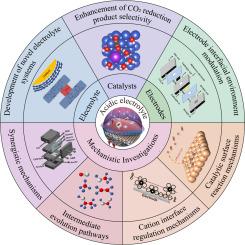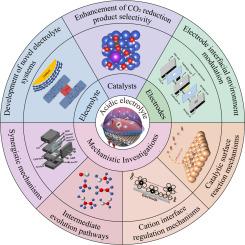Driving high-efficiency carbon utilization: Acidic CO2 electroreduction
IF 13.2
1区 工程技术
Q1 ENGINEERING, CHEMICAL
引用次数: 0
Abstract
Electrocatalytic carbon dioxide reduction (ECO2RR) converts the greenhouse gas CO2 into high-value fuels and chemicals, offering a crucial pathway for achieving a sustainable carbon cycle. Compared to traditional alkaline/neutral systems plagued by severe carbonate deposition leading to low energy efficiency, acidic ECO2RR fundamentally suppresses carbonate formation, thereby enabling efficient carbon cycling and energy utilization. However, the core challenges of this system lie in the intense competition from the hydrogen evolution reaction (HER), mass transport limitations, and insufficient system stability. Addressing these challenges hinges on modulation across three key aspects: catalysts, electrodes, and electrolytes. This includes suppressing HER and enhancing reaction kinetics through catalyst microenvironment engineering and active site design; optimizing electrode structures and modifying interfaces to improve mass transport and corrosion resistance; and regulating electrolyte composition to stabilize the reaction interface while exploring metal-free cation strategies. Currently, comprehensive reviews detailing strategies across catalysts, electrodes, and electrolytes to promote acidic ECO2RR remain scarce. Therefore, this review focuses on the acidic ECO2RR system, systematically summarizing its fundamental principles, key challenges, targeted solutions, performance evaluation metrics, and current development status. It also provides future perspectives aimed at offering fresh insights to advance the development of acidic ECO2RR.


推动高效碳利用:酸性CO2电还原
电催化二氧化碳还原(ECO2RR)将温室气体二氧化碳转化为高价值的燃料和化学品,为实现可持续的碳循环提供了重要途径。与传统的碱性/中性体系相比,酸性ECO2RR从根本上抑制了碳酸盐的形成,从而实现了高效的碳循环和能源利用。然而,该系统的核心挑战在于析氢反应(HER)的激烈竞争、质量输运的局限性以及系统稳定性不足。解决这些挑战取决于三个关键方面的调制:催化剂、电极和电解质。这包括通过催化剂微环境工程和活性位点设计来抑制HER和增强反应动力学;优化电极结构和修改界面,提高传质和耐腐蚀性;调节电解质组成稳定反应界面,探索无金属阳离子策略。目前,关于催化剂、电极和电解质促进酸性ECO2RR的综合综述仍然很少。因此,本文以酸性ECO2RR系统为研究对象,系统总结其基本原理、主要挑战、针对性解决方案、性能评价指标及发展现状。它还提供了未来的观点,旨在提供新的见解,以推动酸性ECO2RR的发展。
本文章由计算机程序翻译,如有差异,请以英文原文为准。
求助全文
约1分钟内获得全文
求助全文
来源期刊

Chemical Engineering Journal
工程技术-工程:化工
CiteScore
21.70
自引率
9.30%
发文量
6781
审稿时长
2.4 months
期刊介绍:
The Chemical Engineering Journal is an international research journal that invites contributions of original and novel fundamental research. It aims to provide an international platform for presenting original fundamental research, interpretative reviews, and discussions on new developments in chemical engineering. The journal welcomes papers that describe novel theory and its practical application, as well as those that demonstrate the transfer of techniques from other disciplines. It also welcomes reports on carefully conducted experimental work that is soundly interpreted. The main focus of the journal is on original and rigorous research results that have broad significance. The Catalysis section within the Chemical Engineering Journal focuses specifically on Experimental and Theoretical studies in the fields of heterogeneous catalysis, molecular catalysis, and biocatalysis. These studies have industrial impact on various sectors such as chemicals, energy, materials, foods, healthcare, and environmental protection.
 求助内容:
求助内容: 应助结果提醒方式:
应助结果提醒方式:


